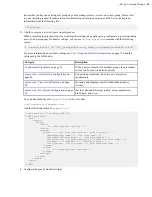
| Configure the Server from the Command Line |
48
Field
Description
Values
Default
many FASP sessions run at the same
time), and shallow buffers (limited
packet queuing capability of a router).
When LAQ is set, then it uses the FD31
RTT predictor unless a different RTT
predictor is explicitly set.
To set a rate control module for outgoing
traffic, set it from the command line
aspera.conf - Transfer Configuration
on
page 42).
TCP Friendly (for
incoming
rate control)
This setting is meant for advanced users to
turn TCP-friendly mode on or off (which
is only applied at the local "receiver"
side when the transfer policy is set to
fair
). It should only be used with special
instructions for debugging. When enabled
("
true
"), incoming FASP transfers are
allowed to maintain relative fair bandwidth
share with a TCP flow under congestion.
true
or
false
false
Incoming Traffic RTT
Predictor
The type of predictor to use to compensate
for feedback delay when measuring
RTT. An experimental feature that
might increase transfer rate stability
and throughput by predicting network
congestion. When set to
unset
, the client-
specified predictor is used and if the client
does not specify a predictor, then none is
used. For more information, see
Transfer Performance by Using an RTT
on page 62.
unset
,
none
,
alphabeta
,
fd31
,
bezier
,
ets
unset
Incoming Rate Control
Target Queue
The method for calculating the target
queue. Static queuing is good for most
internet connections, whereas dynamic
queuing is good for satellite and other
radio connections. For more information,
see
Increasing Transfer Performance by
on page 62.
When set to
unset
, the client-specified
transfer queuing method is used and if the
client does not specify a queuing method,
then
static
is used.
unset
,
static
,
dynamic
unset
Outgoing Vlink ID
The ID of the vlink to apply to outgoing
transfers. Vlinks are a way to define
aggregate transfer policies. For more
information, see .
Vlink ID
Undefined
(Disabled)
Outgoing Target Rate
Cap (Kbps)
The maximum target rate for outgoing
transfers, in kilobits per second. No
transfer session can exceed this rate at any
time. If the client requests an initial rate
greater than the target rate cap, the transfer
proceeds at the target rate cap. The default
positive integer
unlimited
















































